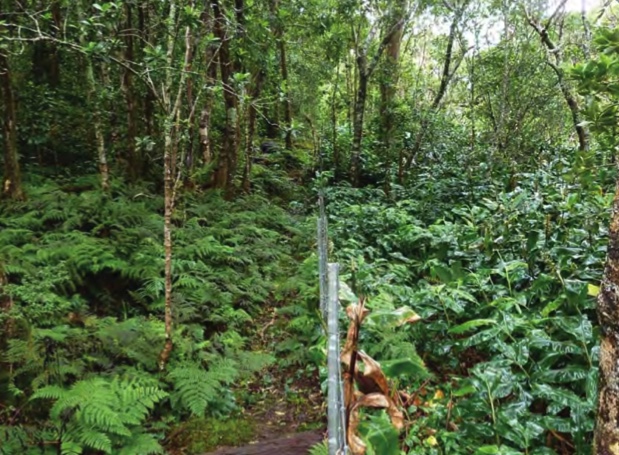
Also at its June meeting, the commission approved a joint funding agreement with the U.S. Geological Survey for a $100,000 study to determine what kinds of data should be collected to determine impacts of native and non-native plant species on freshwater availability in different regions of Maui.
The study is part of a larger project that started in April 2016 and includes similar work in regions throughout the state. During phase 1A, the USGS was supposed to study various aspects of species- associated transpiration and infiltration rates and develop a phase 1B plan for field monitoring “to quantify plot-scale rates of rainfall, net precipitation, cloud-water interception, evapotranspiration, and groundwater recharge for different plant species,” a commission report states.
However, the USGS faced a number of problems in phase 1A and decided to shift the focus of phase 1B, the agency’s Alan Mair told the commission.
Commission staffer Lenore Ohye explained that the USGS had some difficulty finding paired plots in various regions: Leeward, windward, above and below the cloud base, areas with different species compositions, and so on.
“We had difficulty with site reconnaissance,” Mair added. Considering all of the different potential forest sites throughout the state that would need to be studied, as well as the long list of non-native species that had been identified through workshops, “it became clear it would be very challenging to find different sites in all these different environments,” he said. He added that the agency also found in the first phase that plants behaved differ- ently in different environments. “One set of data is not going to answer the question,” he said.
Instead of pursuing fieldwork, the USGS has proposed to use the data collected in phase 1A to conduct water budget modeling.
Commissioner Mike Buck, a former administrator of the state Division of Forestry and Wildlife (DOFAW), pointed out earlier in the meeting that in his opinion, the type of landscape structure matters more in terms of water infiltration rates than whether the forest species are native or non-native.
“If we talk about groundwater on Maui, it’s clear any forest land is better than grass land. The infiltration rates between native and non-native is unclear. … If you’re going to focus on certain species, there are certain non-natives that change the structure of the forest,” he said.
Ohye stressed the project’s importance to both the commission’s work and that of the DOFAW, which manages the state forest reserves and oversees public-private watershed partnerships.
“The reason we’re doing this is to support watershed partnerships. … There is often a question from funders: Is this a good return on investment? Are we going to get good watershed recharge?” Ohye said. She added that the studies will also help the Water Commission staff determine groundwater recharge estimates that are necessary to determine sustainable yields for aquifers throughout the state.
Commissioner Neil Hannahs raised concerns about some of the data the USGS had collected in phase 1A. At Maluhia on the windward side of West Maui, he noted, data showed that infiltration rates were significantly higher in plots dominated by invasive strawberry guava compared to plots dominated by native uluhe fern.
“When you look at it in a very limited way like this, it’s also dangerous when it can be looked at and picked out of context to suggest a pathway forward in terms of managing our forest in a way that most of us would agree would be disastrous. How do you prevent that kind of abuse of data once it’s produced? … How do you ensure that your data is presented in a way that really considers and has the footnote at least that those other things do matter?” Hannahs asked Mair.
Commission chair and Department of Land and Natural Resources director Suzanne Case noted that uluhe typically grows in disturbed, open areas. “Maybe uluhe compared to strawberry guava is the wrong kind of comparison because you’re not comparing a strawberry guava forest to a native forest,” she said.
“And strawberry guava is habitat-transforming, so once you kind of start, it continues to rage through the forest,” Hannahs added.
Mair said that the USGS publishes its data releases without any interpretive analysis. He added that another comparison between uluhe and strawberry guava in a different region of Maui, Kahoma, found that the infiltration rates were not very different between the plots.
Rather than continuing to do plot comparisons in phase 1B, “we thought a better approach would be to do some more modeling to guide the data collection efforts,” he said.
Hannahs asked if the study could take a multidisciplinary approach that might include reaching out to cultural practitioners and incorporating their data points.
Mair said more information on species distribution and on what the forest used to look like would give the USGS more confidence in a water budget model.
The joint funding agreement, which was unanimously approved, covers the first $50,000 of study costs, which the USGS will provide. “The Commission had allocated $50,000 in FY 2020 to match the USGS’ available funding. However, due to the economic fallout associated with the COVID19 virus, use of Commission funds has been restricted. Therefore, the USGS is now proposing to solely fund this water budget sensitivity study,” the staff report states.
— Teresa Dawson

Leave a Reply